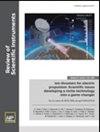The effect of feed mechanisms on the structural design of flexible antennas, and research on their material processing and applications
IF 1.3
4区 工程技术
Q3 INSTRUMENTS & INSTRUMENTATION
引用次数: 0
Abstract
Flexible antennas are widely used in mobile communications, the Internet of Things, personalized medicine, aerospace, and military technologies due to their superior performance in terms of adaptability, impact resistance, high degree of freedom, miniaturization of structures, and cost-effectiveness. With excellent flexibility and portability, these antennas are now being integrated into paper, textiles, and even the human body to withstand the various mechanical stresses of daily life without compromising their performance. The purpose of this paper is to provide a comprehensive overview of the basic principles and current development of flexible antennas, systematically analyze the key performance factors of flexible antennas, such as structure, process, material, and application environment, and then discuss in detail the design structure, material selection, preparation process, and corresponding experimental validation of flexible antennas. Flexible antenna design in mobile communication, wearable devices, biomedical technology, and other fields in recent years has been emphasized. Finally, the development status of flexible antenna technology is summarized, and its future development trend and research direction are proposed.馈电机制对柔性天线结构设计的影响及其材料加工和应用研究
柔性天线因其在适应性、抗冲击性、高自由度、结构微型化和成本效益等方面的卓越性能,被广泛应用于移动通信、物联网、个性化医疗、航空航天和军事技术领域。凭借出色的灵活性和便携性,这些天线目前正被集成到纸张、纺织品甚至人体中,以承受日常生活中的各种机械压力而不影响其性能。本文旨在全面概述柔性天线的基本原理和发展现状,系统分析柔性天线的结构、工艺、材料、应用环境等关键性能因素,进而详细论述柔性天线的设计结构、材料选择、制备工艺以及相应的实验验证。重点介绍了近年来柔性天线设计在移动通信、可穿戴设备、生物医学技术等领域的应用。最后,总结了柔性天线技术的发展现状,并提出了其未来的发展趋势和研究方向。
本文章由计算机程序翻译,如有差异,请以英文原文为准。
求助全文
约1分钟内获得全文
求助全文
来源期刊

Review of Scientific Instruments
工程技术-物理:应用
CiteScore
3.00
自引率
12.50%
发文量
758
审稿时长
2.6 months
期刊介绍:
Review of Scientific Instruments, is committed to the publication of advances in scientific instruments, apparatuses, and techniques. RSI seeks to meet the needs of engineers and scientists in physics, chemistry, and the life sciences.
 求助内容:
求助内容: 应助结果提醒方式:
应助结果提醒方式:


